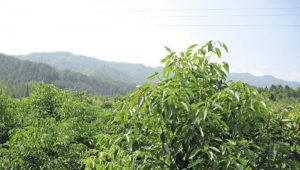
Find out more about the Rosewood plant of our Aromatherapy Herbarium blog series.

ROSEWOOD
Aniba rosaeodora var. amazonica
DIRECTIONS

Rosewood (Aniba rosaeodora) is a tree from the Laureaceae family, native of the Amazon and Guyana.
ADVICE
Essential oil of rosewood is remarkably well-tolerated.
DO NOT USE IN
– pregnant or breast-feeding women,
– children under the age of three years,
– persons allergic to one of the components (geraniol, linalool, limonene),
– persons with asthma without the advice of an allergologist before the first use.
RECIPES
Depression
1 drop of EO of tea tree, 1 drop of EO of rosewood, 1 drop of EO of marjoram, 1 drop of EO of neroli, 1 drop of EO of rosemary verbenone, 1 drop of EO of lemon verbena.
Apply this mixture on the solar plexus, arch of the foot, internal side of the wrists and along the spinal column two times daily over two weeks.
Skin Moisturising
Place 2 drops of essential oil of rosewood in a teaspoon of borage, sweet almond or evening primrose oil or in your usual skincare cream. NB: essential oil of rosewood is increasingly difficult to find (especially in organic quality), due to forest overexploitation. You may replace it by Asia rosewood (Cinnamomum camphora linalolifera, which has a very similar chemical formula) in all the recipes in this book.

Its fine grained, fragrant, pinkish wood is hard, compact and tough. It is used in perfumery and woodworking where several species of the Dalbergia genus are used, which also includes the rosewoods. In Brazil, the local rosewood is Dalbergia nigra. Another family, the Fabaceae, includes wood species which are commonly referred to as rosewood. This includes in particular Pterocarpus indicus, which refers to the rosewood from Burma. Thespesia populnea, of the Malvaceae family, is also called rosewood. The tree was discovered in 1925 in the Amazonian forest, were Indians had always used it in their traditional pharmacopoeia. Since then, it has been overexploited, and in the 1960s, fifty thousand tonnes were felled every year. In Madagascar this frantic overexploitation caused a scandal and its export was forbidden (see p. 81). Rosewood which is a threatened species is now protected by the International union for conservation of nature (IUCN). Synonymous in the west with refinement and luxury, it has inspired writers from Balzac to Sharyn McCrumb, (The rosewood casket, 1999).
CULTIVATION AND PRODUCTION
Following a period of overexploitation, Brazil (Amazon basin) now protects rosewood, and has become the almost exclusive producer. Guyana has been replanting.
FRAGRANCE
The refreshing and sweet smell of rosewood, vaguely evokes that of rose.
EXTRACTION AND YIELD
The productive organ is the wood, treated by steam distillation of wood chips. The essential oil yield is approximately 5%, i.e. five kilograms per one hundred kilograms of plant.
CHEMICAL FORMULA
The active constituent of essential oil of rosewood is linalool, containing up to 92%.
MAIN INDICATIONS
Essential oil of rosewood is the skin’s best friend. A powerful tissue regenerator, it softens, embellishes, firms up the skin and removes stretch marks, wrinkles, eczema, acne and other skin disorders. It is an excellent lymphatic tonic. Rich in linalool, it has anti-infectious, anti-bacterial, anti-fungal and anti-viral properties, and reinforces immune defences. It is also anti-spasmodic and soothing.
CHEMICALLY RELATED SPECIES
Asian rosewood, Ho wood, Shiu wood (Cinnamomum camphora linalolifera).


Leave a Comment